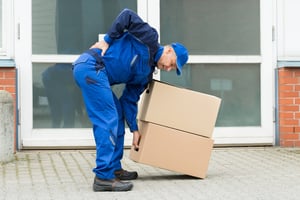 Our spine bears the weight of all of our daily activities, from how frequently we move to how much weight we lift at one time. With so much pressure put on our spinal discs, it’s no surprise that many of our daily activities can impact our spine health. The following lifestyle risks can cause pain, strain, and in some cases can even cause lumbar disc herniation.
Our spine bears the weight of all of our daily activities, from how frequently we move to how much weight we lift at one time. With so much pressure put on our spinal discs, it’s no surprise that many of our daily activities can impact our spine health. The following lifestyle risks can cause pain, strain, and in some cases can even cause lumbar disc herniation.
1. Sedentary Lifestyle
Sitting for long periods of time can put pressure on the spine due to dehydration of the lumbar discs. Frequently changing positions is essential1 to promote flow of fluid and nutrients to the discs. Pressure fluctuations can occur based on sitting posture and overall level of lower back support.
A study2 suggests that using a backrest and/or armrests for support, as well as decreasing the flexion angle of the upper body, can reduce spinal loads while sitting. Driving, especially for long periods of time, can also put excess strain on the spine. When driving long distances, try to stop, stand, and stretch every few hours to minimize pain and decrease risk of spinal injury or irritation.
2. Heavy Lifting
Heavy lifting without bending the knees puts a serious strain on the spine. Although no universal weight amount is defined as “heavy,” it’s typically considered anywhere from 20 to 50 pounds, depending on the individual—but it doesn't require time spent at the gym or lifting weights. In this case, heavy lifting could mean everything from unloading groceries from the trunk of your car and carrying a basket of laundry to lifting a large dog or child.
One experiment3 found that lifting and carrying a bottled beverage case with a weight of around 43 pounds put the most pressure on the spine, more than twice as much pressure caused by jogging and eight times as much pressure as is contained in the average car tire. Always use proper lifting techniques, such as bending at the knees, to minimize pressure on your spine and reduce the risk of lumbar disc herniation.
3. High-Impact Exercise
High-impact exercise with poor form can also cause lumbar disc herniation. For instance, any exercises that involve a lot of twisting or bending can put excess pressure on the spine. High-impact activities such as jogging, aerobics, and martial arts can all be very jarring, especially for those with existing issues with back and leg pain.
In fact, according to the National Spine Health Foundation4, “any repetitive exercise, with or without load, where the lumbar spine is allowed to flex, round, or flatten, will over-stress the discs and ligaments.” On the other hand, low-impact exercises like swimming, walking, and cycling put less pressure on the spinal discs and also help relieve painful symptoms caused by disc herniation.
4. Poor Sleeping Position
Stomach and side sleeping positions5 have been linked to chronic back pain. To reduce your risk of pain and potential lumbar disc herniation, avoid sleeping on your stomach. When sleeping on your side, try placing a pillow between your legs and switching sides occasionally to reduce strain on your spine.
Regardless of how you sleep, the pressure in your disc may double (or more!) overnight as your disc rehydrates. A study found6 that after seven hours of sleep, spinal pressure increased 240 percent. Some research7 even suggests that your lumbar discs may be more susceptible to herniation earlier in the day, so take extra precautions in the morning.
5. Household Activities
Activities like cleaning and gardening that involve a lot of bending over, twisting, and lifting can also put excess pressure on your spine. This is especially true when you’re remaining in the same position for hours on end, such as bending over your garden without taking breaks to stretch. If you already struggle with sciatica due to a herniated disc, gardening and other household activities can be particularly troublesome.
Protecting Your Spine with Healthy Habits
Seemingly harmless daily activities can impact spine health and even cause lumbar disc herniation. With that said, you can protect your spine and prevent a herniated lumbar disc by engaging in healthy habits, like practicing good posture, using proper lifting techniques, and staying active.
While this blog is meant to provide you with information to support your well-being while considering or waiting for spinal surgery, it is not intended to replace professional medical care or provide medical advice. If you have any questions about the information given, please ask your doctor, who is the only one qualified to diagnose and treat your pain and spinal condition.
References:
1 H J Wilke et al, “New in vivo measurements of pressures in the intervertebral disc in daily life,” Spine 24, no. 8 (1999): 755-62, doi: 10.1097/00007632-199904150-00005.
2 Antonius Rholmann PdD et al, “Measured loads on a vertebral body replacement during sitting,” The Spine Journal 11, no. 9 (2011): 870-875, doi: 10.1016/j.spinee.2011.06.017.
3 See note #1.
4 Jason Arnett, “Breaking Down the Exercises That Break Down Your Spine,” National Spine Health Foundation, accessed September 30, 2020, https://spinehealth.org/breaking-down-the-exercises-that-break-down-your-spine.
5 Ashley Marcin, “The Best Sleeping Positions for Lower Back Pain, Alignment Tips, and More,” Healthline, August 25, 2020, https://www.healthline.com/health/healthy-sleep/best-sleeping-position-for-lower-back-pain.
6 See note #1.
7 MA Adams et al, “Diurnal variations in the stresses on the lumbar spine,” Spine 12, no. 2 (1987): 130-137, doi: 10.1097/00007632-198703000-00008.




Comments